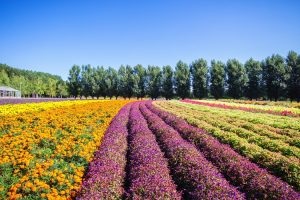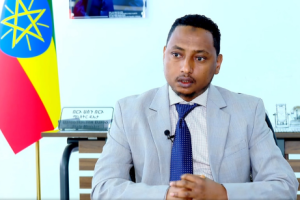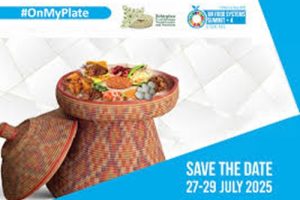
BY BACHA ZEWDIE
The sounds of the calves and milk cows, which are called “Embwa” in the area, create a different feeling due to their abundance. The voice is strange not only to a stranger, but also to the pastoralist and the farmer, EPA reporter expressed her observation.
A visitor who sees a large number of calves gathered in one place may think that their market has started. On Monday, September 19, 2022, when she was in Bona and Bensa districts under Sidama region, she saw the calves and milk cows that she was amazed by.
Most of the calves in the two districts were obtained through the synchronization method; and the milk cows are ready for additional breeding method by experts.
On that day, the farmers with good results by using the improved breed early and a large number of farmers holding their calves came with their cows to benefit from the breeding seeing the experiences of their antecedents. Professionals were performing their duties from 6:00 AM in the morning to prepare the cows for further breed improvement.
Celebrating the calves’ day born through synchronization method in the just ended fiscal year and launching a new breed improvement program for the new fiscal year was conducted officially. The program was attended by Beyene Barasa, Deputy Head of the Sidama Region and Head of the Education Office including the leaders of the region at all levels and the local community those highlighted the farmers’ movement program.
It was understood that the improvement of animal species in the region has been underway for a long time. Every year it is customary to show the past results and carry out the next launch program.
Such a program is conducted every year in order to carry out the movement to spread the experience of the improvement of animals species started in certain districts of the region and the results obtained in all the districts of the region. The main objective of the movement program is to increase dairy productivity.
It is frequently stated that the farmers are not getting income from the inseparable activities of crop cultivation and animal husbandry in the agricultural sector, especially by offering the animals and animal products to the market. As a country, even though Ethiopia is known for its cattle wealth, it is known that the milk and meat productivity of the animals is low, especially the amount of milk obtained from indigenous cows is very small and it is not possible to meet the needs of the consumers.
The current situation with milk supply and rising prices also indicates this. It is believed that this gap can be filled or improved by using animal breeding methods. The experiences seen in Bona and Bensa districts show that the method is yielding results.
Some of the local residents, who are engaged in milk production with improved milk cow breeds, have been able to be a model for others, testify about its effectiveness. Tagel Shibru, a youth from the Bona district around Bona 01 kebele, was found preparing fodder for the calves at the door of his house using a processing machine or a fodder cutting machine. Tagel prepares fodder using a forage preparation machine called a chopper, which he obtained from a Canadian research center called “Lifes”.
This work, which started in 2006 with two calves of an improved breed, is making Tagel successful. He is working with the principle of “one calf per year” to increase his benefit by expanding his business.
As the young man explained about the results obtained by the animals of improved breeds than the local animals; calves born with improved breeding methods grow faster. The amount of milk obtained from the cows is also high.
A milk cow with an improved breed can produce up to 25 liters of milk per day. This is much more than the milk obtained from a local cow. Currently, the young man has more than 20 milk and meat cattle, and he has benefited by producing 150 liters of milk per day and offering it to the market.
He said that the value of milk production is high because it creates job opportunities for many people in the chain from care, milking and marketing. It was learned from those who have been engaged in the process working on the spot like Tagel that their contribution is high in increasing the supply and consumption of milk.
According to Tekle Jomba, head of the Animal Resources Development Office of Sidama Region, regarding the efforts being made to increase milk productivity with improved animal breeds in the region; the Sidama farming community gives a special place to the animals. Even when exchanging greetings, next to children and family, they ask about the welfare of animals. Providing to market, he makes the animals a source of income. He utilizes some of them for food, transportation, and security.
He takes great care of these animals. He does not even keep them away from his house. Unfortunately, a farming community that gives such respect to animals is not getting significant benefits from its animals and their products. The problem is not only low productivity of the animal species; it has been identified in different ways that due to lack of paying proper attention to their health, traditional handling and management, lack of fodder and various factors have negative impact on their utilization.
Tekle said that although it is long time since implementation of the method was began to increase the farmers’ beneficiary; it has been done with special attention and a wide movement just following establishment of Sidama as a region.
As to him, there are more than 2.9 million cattle in the region. Only 11 % of them have been improved. The largest number of the cattle is milk cows whose species is not improved and do not produce more than one liter of milk per day. In this situation, it is impossible to meet the needs of the consumers and income of the farmers.
With the revival model to use improved animal species and increase productivity, it has been possible to create farmers and young people who are interested in working in a union. Only in one kebele of Bona district, it was possible to breed more than 300 improved calves. Achieving such results in one kebele, it is easy to imagine that there would be many calves of improved species in 20 kebeles of Bona district. This demonstrates the attention given by the region and the achievement gained. If it is possible to confirm the effectiveness of the activity by expanding the experience, it will be possible to increase the development of dairy and beef cattle in the region in a short period of time.
The region has presented Bona and Bensa districts as model for their results, and the farmers are committed to cultivating, handling and managing fodder for the animals in addition to their desire to breed improved animals. As a result, the activity of working with the farmers from the district leadership to the bottom was encouraging. In general, they have recorded an exemplary performance for others.
Tekle further explained that breeding is being done using improved bulls from India, and the bulls are of two types. Another breed that has been improved by importing female calves from Korea and India is a species that can be used for breeding.
Farmers know the species very well. It is easy to use. Breeding work is done in locally built improvement centers, and hybridization is done locally by experienced professionals. The region provides resources for breeding. Since the service is free, all that is expected from the farmers is to be ready to improve the animals’ species.
If this service is valued in money, it will require no less than 30 thousand Birr to improve one cattle species. It can be understood from the number of farmers found with their cattle in the movement program that was held in one day in one kebele that the farmers are realizing the importance of improving the species and the necessary cost. It can be said that the work of improving the species is inducing initiative.
The region has designed short-term and long-term plans in its efforts to increase productivity by improving the species of the cattle. Effort is underway to improve 60 % of animals’ species within ten years. As per the short term plan, maximum effort is exerted to improve species of 101,000 animals and to obtain 71 thousand calves in the current fiscal year.
There are 30 rural districts and 7 urban administrations in the region and the work on resources, manpower, planning, common understanding, training the farmers and other activities essential for species improvement that started in 37 structures have been completed during the preliminary preparations.
According to Beyene Barasa, Deputy Head of Sidama Region and Head of the Education Bureau; since the establishment of the region, Sidama has been trying to address the people’s demand for development in different ways. Up on accessibility of road infrastructure, easier transportation would be available not only for people, but also for crops products and livestock. Other infrastructural works should also change people’s lives.
This can be achieved consequently to the work that increases the income of every resident of the region. The issue of creating modern breeding by improving animal species plays an important role in ensuring family prosperity. Therefore, result-based work is expected.
The Deputy Head of the State and Head of Education Bureau said that they realized from the day’s program that the current activity is encouraging. He stressed that it is not necessary to carry out agricultural work on a large land, but to increase productivity on a small land. He pointed out that such an approach is a unique method to avoid the problem of land scarcity.
THE ETHIOPIAN HERALD WEDNESDAY 5 OCTOBER 2022





